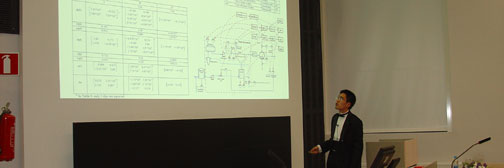| | Year 2004
Tua WikströmRetention Control In Newspaper Machine
The objective of this thesis was to improve retention, i.e. by better retention aid feed control to improve runnability of paper machine 4 in Kajaani. The other objective was to save raw material consumption by optimizing the retention level. This thesis was made for UPM-Kymmene, Kajaani paper machine 4, in co-operation with Metso-Automation
The aim of the literature part was to discuss the effect of surface on colloidal chemistry on retention, different retention mechanisms and retention methods. Furthermore the effect of wet end variables on paper quality and paper machine runnability was described. In literature part were also an introduction to multivariable process control and utilization of cost account model in evaluation of process control performance.
The experimental part was divided into two parts. In the first one was the diagonal and decoupled retention aid feed control strategies compared during a ten-day trial by taking into account the chemical, fiber and steam consumption in a cost accounting model. During the trial there were several grade changes, which could not be taken into account with a static cost account model. On the other hand, the cost accounting model made it possible to define the cost structure.
The objective of the second part of the experimental work was to optimize retention level. For this purpose were white water charge and head box freeness analyzers installed. White water charge can be utilized in retention optimization. A correlation between white water consistency and white water charge was found. According to this, the white water charge decreased when white water consistency increased. According to research, the white water charge is too low in paper machine 4 for efficient use of retention aid. Trials done on paper machine 4 showed that the white water charge can be increased and retention aid feed decreased by adding fixative to the process. The white water charge and head box freeness can be used to control the short circulation, and well- controlled short circulation improves the retention. The white water charge can be used as an indication of heavy loading of short circulation. There was also some indication that white water charge fluctuations and level may correlate with beaks, especially when raw water temperature decreases. The head box freeness affects the efficiency of the disc filter. If the freeness is low, i.e. the fibers are short and the level of fines is high, the efficiency of the disc filter decreases. Decreased efficiency of the disc filter may increase fluctuations in white water charge.
Deprecated: strlen(): Passing null to parameter #1 ($string) of type string is deprecated in C:\WWWroot\Root\incs\5_theses\theses_new2010.php on line 248
This info last modified 27 Apr 2024 - contact webmaster
|

